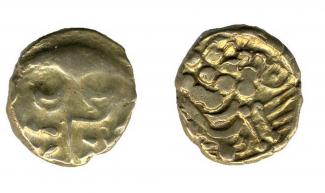Gold 'Cheriton' (British D) stater
Late pre-Roman Iron Age, 25-0BC
Found at Cheriton, Hampshire, by metal-detectorist in 1992
This coin is one of sixteen staters (British D) and quarter staters (British O) that are thought to be part of the Cheriton Hoard found in 1983. The type derives from the French 'Gallo-Belgic C' series whose design echoes the gold stater of Philip II of Macedon with the laurel-wreathed head of Apollo on the obverse and the two-horsed chariot on the reverse. The Cheriton staters show these designs in abstract 'Celticized' form. The vast majority of British Celtic coins, such as these, were produced by striking a flattened blank between two dies on which the obverse and reverse designs were engraved. The dies tended to be bigger than the area of the blank - often by as much as twice the width of the image on the coin, which thus shows only a part of the design.
Acquired with the assistance of the MGC/Victoria and Albert Museum Purchase Grant Fund.



